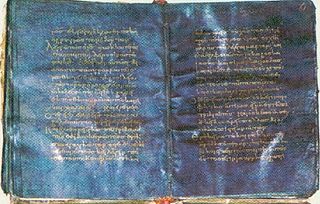
The Biblioteca Nazionale Vittorio Emanuele III is a national library of Italy. It occupies the eastern wing of the 18th-century Palazzo Reale in Naples, at 1 Piazza del Plebiscito, and has entrances from piazza Trieste e Trento. It is funded and organised by the Direzione Generale per i Beni Librari and the Ministero per i Beni e le Attività Culturali.

Minuscule 565, ε 93, also known as the Empress Theodora's Codex, is a Greek minuscule manuscript of the New Testament, written on purple parchment. Using the study of comparative writing styles (palaeography), it has been assigned to the 9th century. It was labelled by Biblical scholar Frederick H. A. Scrivener as 473. The manuscript has several gaps. It has marginalia.
Papyrus 34, designated by 𝔓34, is a copy of the New Testament in Greek. It is a papyrus manuscript of the Pauline epistles, it contains 1 Cor 16:4-7.10; 2 Cor 5:18-21; 10:13-14; 11:2.4.6-7. The manuscript paleographically has been assigned to the 7th century.
Papyrus 55, signed by 𝔓55, is a copy of the New Testament in Greek. It is a papyrus manuscript of the Gospel of John. The surviving texts of John are verses 1:31-33, 35–38.
Papyrus 56, signed by 𝔓56, is an early copy of the New Testament in Greek. It is a papyrus manuscript of the Acts of the Apostles, it contains only Acts 1:1.4-5.7.10-11.
Papyrus 76, signed by 𝔓76, is a copy of the New Testament in Greek. It is a papyrus manuscript of the Gospel of John. The surviving texts of John are verses 4:9,12.
Minuscule 154, Θε402 (Soden), is a Greek minuscule manuscript of the New Testament, on cotton paper. Palaeographically it has been assigned to the 13th-century. It has complex contents, and full marginalia.
Minuscule 155, ε 403 (Soden), is a Greek minuscule manuscript of the New Testament, on parchment. Palaeographically it has been assigned to the 13th century. It has marginalia.
Minuscule 158, ε 108 (Soden), is a Greek minuscule manuscript of the New Testament, on parchment. Palaeographically it has been assigned to the 11th century. It has marginalia.
Minuscule 386, δ 401 (Soden), is a Greek minuscule manuscript of the New Testament, on parchment. Paleographically it has been assigned to the 14th century. It has complex context and some marginalia.
Minuscule 387, ε 205 (Soden), is a Greek minuscule manuscript of the New Testament, on parchment. Paleographically it has been assigned to the 12th century. It has marginalia.
Minuscule 424, Ο12, is a Greek minuscule manuscript of the New Testament containing the book of Acts, the Pauline Epistles, the Catholic Epistles, and Revelation, written on parchment. Using the study of comparative writing styles (palaeography), it has been assigned to the 11th century. It was formerly designated by the number 66a (Acts), 67p (Epistles), and 34r (Revelation).
Lectionary 142, designated by siglum ℓ142 is a Greek manuscript of the New Testament, on parchment leaves. Paleographically it has been assigned to the 14th century.
Minuscule 628, α 400, is a Greek–Latin diglot minuscule manuscript of the New Testament, on paper. Palaeographically it has been assigned to the 14th century. The manuscript is lacunose. Formerly it was labeled by 161a, 198p, and 69r.
Minuscule 631, α 1604, is a Greek minuscule manuscript of the New Testament on paper. It is known as Codex Ottobonianus. Palaeographically it has been assigned to the 15th century. Formerly it was labeled by 165a.
Minuscule 852, ε406, is a 14th-century Greek minuscule manuscript of the New Testament on parchment. The manuscript has not survived in complete condition.
Minuscule 878, Θε200, is a 12th-century Greek minuscule manuscript of the New Testament on parchment. It has complex contents.
Minuscule 881, Θε51, is a 15th-century Greek minuscule manuscript of the New Testament on paper. It has complex contents.
Minuscule 887, is an 11th-century Greek minuscule manuscript of the New Testament on parchment, with a commentary.